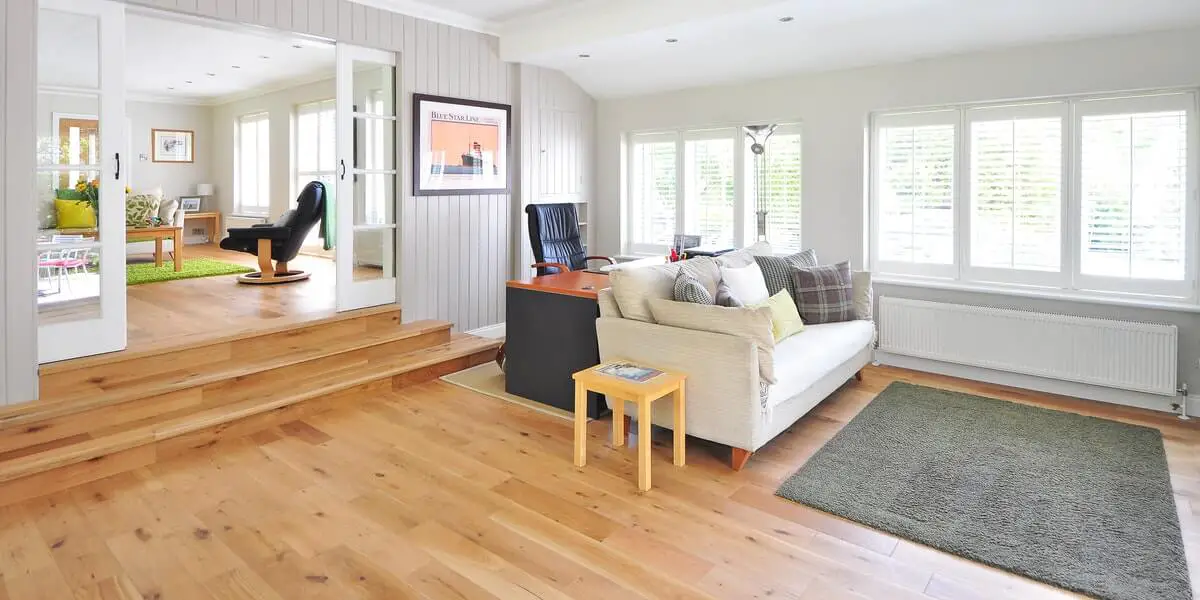What is Engineered Wood Flooring?
Engineered wood flooring consists of several layers of wood veneer, with the top layer being genuine hardwood and the inner layer using woods such as pine and spruce.
Engineered wood flooring is more durable, stable, and resistant to temperatures, moisture, and humidity. It is designed to provide the look and feel of traditional hardwood flooring with more stability and durability.
How Is Hardwood Flooring Made?
Engineered Wood Flooring material mainly comprises three layers: Front Layer, Core Layer, and Back Layer. These three layers are glued with strong glue and passed through high heat and pressure. The process of making it is similar to plywood. The entire structure is chemically treated to make it insect and rot-resistant.
Front Layer: The top layer is made of genuine hardwood veneer. It looks like natural wood and provides aesthetic beauty. It can be made from various wood species, such as oak, maple, or cherry.
Core Layers: The core or inner layers contain multiple cross-laminated veneers. These layers are glued in alternate directions to increase the stability and strength of the floor.
Back Layer: The back or bottom layer acts as a stabilizing force and is usually made of a thin layer of wood. The bottom helps balance the structure of the floor and provides additional support.
Engineered Wood Flooring Advantages and Disadvantages
Each flooring material has some advantages and disadvantages. Engineered wood flooring has pros and cons, so you should know its limitations before installing engineered wood flooring.
These are some advantages and disadvantages of Engineered Wood Flooring.
Advantages
1. Appearance
Engineered wood flooring looks similar to solid hardwood. The top layer is made of real wood veneer (a thin layer of wood), giving an authentic and natural wood texture.
2. Extreme Stable
A solid can expand and shrink at different temperatures, whereas engineering wood is weather and moisture-resistant, so it is not affected by the weather.
3. Easy Installation
Engineering wood flooring is easy to install. It is available in many sizes and thicknesses in the market. It does not require much experience and tools to install. Some handy homeowners are installing their own engineered floors.
4. Refinishing
The biggest advantage of engineered wood flooring is that it can be refinished like solid wood flooring and made new again. But it can be refinished only a limited number of times depending on the thickness of the material as the layer is a thin wood veneer.
5. Affordable
Generally, Engineered wood flooring is more affordable than solid wood flooring, and the replacement and maintenance of Engineered wood flooring is also cheaper.
6. Temperature Resistance
Engineered wood flooring is more resistant to temperature compared to solid hardwood flooring due to its construction.
7. Durability
Engineered wood flooring is made of multiple layers of wood. All layers are placed at an angle of 90 degrees to each other, due to which both their stability and durability increase. Some professional flooring companies offer warranties on engineered wood flooring for 20-30 years or more.
9. Availability
Engineered wood floors come in various colors, grades and finishes so that you can choose the best one according to the color of your room.
Disadvantages
1. Low-Quality Core Construction
The interior or core veneer of an engineered flooring material may need better quality. Which can expand and shrink due to exposure to moisture or weather. That’s why you always buy good quality flooring material.
2. Limited Refinishing
The top layer of Engineered Wood Flooring material is thin and can be refinished only a limited number of times, whereas solid wood flooring can be refinished many times.
3. Fading over time
Fading is another major problem with engineered wood floors. Often this problem is caused by excess heat and UV rays. But you can reduce this problem by covering such places with curtains or rugs.
4. Potentially weak
Engineered wood flooring has many advantages but is less strong than solid wood flooring. Engineered flooring requires proper care and maintenance because it is pron to cracks and scratches.
5. Termite Attack
Engineered wood can be prone to termites and rot if the flooring material is not chemically treated. But we must know that chemically treated flooring material can harm pets or children.
How to Care Engineered Wood Flooring

Engineered wood flooring is an excellent flooring technology. But it also has some flaws, which I have shared with you. But despite the drawbacks of wood flooring, people still prefer engineered wood flooring.
I am sharing some tips with you so that you can enjoy engineered wood flooring to the fullest.
| Do’s | Don’t |
| The vacuum can be used regularly for cleaning. | Overheating or wet is harmful to engineered wood flooring. So protect it from moisture. |
| Trimming your pet’s nails regularly. So that the pets could not scratch the floor. | Never walk on wooden floors wearing spike heels. It can lead to scratches and dents on the floor. |
| Use furniture pads under table legs and castors. | Never use steel wool to clean the floor. It gradually wears off the floor’s shine and roughs the top layers. |
| Use manufacturer-recommended liquid cleaners. | Wax-based cleaners, not powerful detergents, should be used to clean engineered hardwood floors. |
Read another post


Comments are closed.